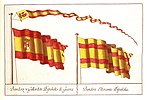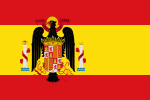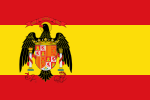Flag of Spain
 | |
| Use | Civil flag and ensign |
|---|---|
| Proportion | 2:3 |
| Adopted | 1843 |
| Design | Two horizontal stripes of red (top and bottom) and yellow (middle). The yellow stripe is twice the height of each red stripe. |
| Designed by | Charles III |
The national flag of Spain (
The origin of the current flag of
Throughout the 19th and the 20th centuries, the colour scheme of the flag remained intact, with the exception of the Second Republic period (1931–1939); the only changes centred on the coat of arms.
Spanish flag legal framework and specifications
- Spanish Constitution of 1978, establishing the national flag:
| La bandera de España está formada por tres franjas horizontales, roja, amarilla y roja, siendo la amarilla de doble anchura que cada una de las rojas. Artículo 4 1 de la constitución española de 1978 |
|
Translation: |
- Act 39/1981, regulating the use of the flag.[3]
- Royal Decree 441/1981, establishing the detailed technical specifications of the colours of the flag.
- Royal Decree 1511/1977, establishing the Regulations on flags, banners and emblems (Reglamento de Banderas y Estandartes, Guiones, Insignias y Distintivos)[4]
- Royal decree of 19 July 1913 (effective 1 January 1913), abolishing the 5-stripe Spanish merchant flag and establishing the plain triband — the national flag without the shield — as the Spanish merchant flag.[5]
Colours
The colours of the flag, as officially defined by the Spanish Royal Decree 441/1981 of 27 February,[6] are:
CIELAB values
|
CIE (Illuminant C) | Hexadecimal code | |||||
|---|---|---|---|---|---|---|---|
| Flag Red (Rojo Bandera) | 35° | 70 | 37 | 0.614 | 0.320 | 9.5 | #BA151B
|
| Flag Gualda Yellow (Amarillo Gualda Bandera) | 85° | 95 | 80 | 0.486 | 0.469 | 56.7 | #FFF200
|
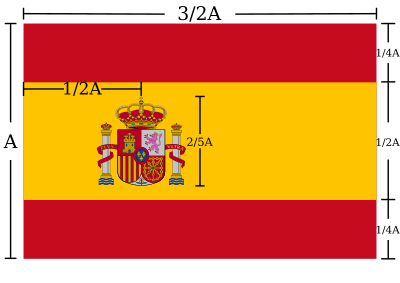
The nearest Pantone shades are 7628 C (red) and 7406 C (yellow).
Design
The basic design of the current flag of Spain with the coat of arms is specified by rule 3 of the Royal Decree 1511/1977, which states the following:
- The coat of arms of Spain has a height equal to 2⁄5 of the hoist (height) and will figure on both sides of the flag.
- When the flag is of regular proportions, having a length equal to 3⁄2 of the width, the coat of arm's axis is placed at a distance from the hoist equal to 1⁄2 of the flag's height.
- If the flag's length is less than normal, the coat of arms is placed at the centre of the flag.
This type of triband design has become known as a Spanish fess.
Flag protocol
The flag must only be flown horizontally. It can be flown from public buildings, private homes, businesses, ships, town squares, or during official ceremonies. While the flag should be flown from sunrise to sunset, government offices in Spain and abroad must fly the flag on a 24-hour basis; during the night, and in poor light, it must be properly lit. The flags must conform to the legal standards, and cannot be soiled or damaged in any way.[3]

For mourning activities, the flag can be flown in either of the following ways. The first method, commonly known as half-masting, is performed when the flag is hoisted to the top of the flagpole, then lowered to the pole's one-third position. The other method is to attach a black ribbon to a flag that is permanently affixed to a staff. The ribbon itself is ten centimetres wide and it is attached to the mast so that the ends of the ribbon reach the bottom of the flag. During the funeral ceremony, the flag may be used to cover the coffins of government officials, soldiers and persons designated by an act of the President; these flags are later folded and presented to the next of kin before interment.[3]

When flying the Spanish flag with other flags, the following is the order of precedence: the national flag, flags of foreign states, the
When unfurled in the presence of other flags, the national flag must not have smaller dimensions and must be situated in a prominent, honourable place, according to the relevant protocol.[3]
Other flags currently in use
-
Customs Service ensign
Civil authorities
Some high-ranking officials of the Spanish state (i.e., the president, the vice-presidents and the ministers of the government, or the chairmen of the
Yacht ensign
The
The Spanish
- First quarter, for Castile: Gules, a tower Or, masoned sable and ajouré azure;
- Second quarter, for León: Argent, a lion rampant gules (differing from the one on the national flag) crowned, langued and armed or;
- Third quarter, for Aragon: Or, four pallets gules;
- Fourth quarter, for Navarre: Gules, a cross, saltire and orle of chains linked together Or, a centre point vert.
Flags for Armed Forces
The flag used by the Spanish Armed Forces is the same one that is used as the state flag and national ensign. Military units, however, use a less oblong, more square version (full size dimensions 12.80 by 14.75 metres (42.0 ft × 48.4 ft)) charged with the name of the unit.[citation needed]
-
Army flag under Francoist Spain (1940–1945)
-
Army flag under Francoist Spain made for Castles and Forts (1940–1945)[10]
Royal Standards of Spain
-
Royal standard of King Emeritus[11]
The
The Royal
The heir to the crown, the
History
-
Catholic Monarchs(until 1492)
-
 Standard of the Crown of Castile
Standard of the Crown of Castile -
 Standard of the Crown of Aragon
Standard of the Crown of Aragon
While the concept of a national flag did not exist in the Middle Ages, the symbol of Spain was the Royal Shield. It was frequently made up of other different flags, full of images and symbols that represented all the values that the troops or the King defended.
Standard of the Catholic monarchs
In Spain the medieval kingdoms which merged in the sixteenth century had their own heraldic symbols and their navies used to display their own flags and standards on both the Mediterranean Sea and the Atlantic Ocean, where the Aragonese and Castilian Crowns had their respective areas of influence. The flag of the
The banner of Castile and León was the first European symbol to arrive in the New World.[14]
Cross of Burgundy



The Cross of Burgundy was introduced to Spain after the marriage of
Habsburg Spain
When the
When
However, at this time the concept of a national flag as understood nowadays did not exist, and so the true symbol of the nationality was represented by the Royal arms. The use of other flags besides the mentioned ones was frequent, with various images or symbols. Some examples are the flag of
Philip V and the new Bourbon dynasty
The arms of
The flags were organized in three groups:
- Standard or Royal flag: it continued being crimson, with the royal arms embroidered, the Golden Fleece and the collar of the Order of the Holy Spirit.
- Military flag: the colour was reduced to white with the Cross of Burgundyand the Royal arms.
- Pavilion of the Navy: again white, with the Royal arms.
Origins of the present ensign: Charles III
-
The original proposals made to Charles III in 1785
-
Merchant marine's flag (1785–1927)

In 1760 Charles III modified the shield of the Royal arms, suppressing the collar of the Holy Spirit, maintained the
The military flag or Coronela of Spanish regiments was, during the Bourbon years, the
When
Second Spanish Republic
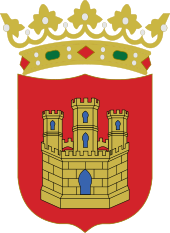
On 14 April 1931, the monarchy was abolished and replaced by the Second Spanish Republic. The regime change was symbolized by a new tricolor flag, red, yellow and murrey (Spanish: morado), instead of the previous red and yellow bicolor, considered, at the time, monarchist. The purported aim of the murrey strip was to represent Castile and León in the flag's colours, as the existing red and yellow represented the territories of the former Crown of Aragon. The Republican flag was officially adopted on 27 April and officially given to the army on 6 May. Formed by three horizontal strips of the same width, red, yellow and morado, with the coat of arms of the Second Spanish Republic at the centre (quarterly of Castile, Leon, Aragon and Navarre, Enté en point for Granada, stamped by a mural crown between the two Pillars of Hercules). Another novelty was the smaller dimensions of this flag in its military version, of 1 m by 1 m.
As for the addition of the murrey to represent Castile in the national flag, since the last quarter of the 20th century there are authors that contradict former historians maintaining that the Castilian banner was not murrey, but crimson.[19]
Spanish State
The Spanish Civil War officially ended on 1 April 1939, when the last Spanish Republican outposts were overrun by the Nationalists. The Republican regime in Spain was destroyed and Francisco Franco became the Caudillo of the country and remained in power until his death on 20 November 1975.
On 29 August 1936, the
On 26 July 1945, the commander's ensigns were suppressed by decree, and on 11 October a detailed regulation of flags was published, that fixed the model of the bi-colour flag in use, with a new version of the Saint John eagle. The models established on that decree were in force until 1977.
During this period two more flags were usually displayed together with the national flag: the flag of
Spanish transition
From the death of Franco in 1975 to 1977, the national flag remained that of the 1945 regulation. On 21 January 1977 a new flag was approved that differed from the previous one in that the eagle's wings opened further (the "pasmada" eagle), the
The national flag of Spain finally received its present-day coat of arms on 19 December 1981.
Unofficial flags
-
Iberian Unionflag proposal in 1854
-
Flag with Osborne bull
-
Spanish flag with the Sacred Heart used by Carlism
- At some point during the 1990s an unofficial version of the Spanish flag sporting an Osborne bull superimposed as some sort of "coat of arms" began appearing in football arenas. This usage has become increasingly popular and this flag is easily seen nowadays during sports events, football or others, which include a Spanish team or player, or the Spanish national team itself.[20]
- The flag of the Second Republic, with the indigo strip, is often seen in rallies organized by those closely associated to the Second Spanish Republic. The flag is mostly used by left-leaning people to dislike for the monarchy. [citation needed].
- A Spanish flag with a superimposed kicked football was used as the emblem of the 1982 FIFA World Cup.[21]
- The yellow and red colours used on the "pecten" logo of Royal Dutch Shell are thought to relate to the colours of the flag of Spain, as Shell built early service stations in the state of California which had strong connections with Spain.[22]
- The Spanish flag is used in the reverse of the Texas state seal as one of the six flags over Texas,[23] as well as in the seal of the city of Mobile, Alabama.[24]
- A new Iberian union is a political prospect proposed by Iberism[25]thinkers in which Portugal and Spain would be united. There are several flag options most of them combining both countries' colours and coats of arms.
See also
Note
References
- ^ "Royal Spanish Navy". Armada.mde.es. Retrieved 2012-03-05.
- ^ Volker Preuß. "National Flaggen des Königreichs Spanien" (in German). Archived from the original on 2012-03-26. Retrieved 2004-11-03.
- ^ a b c d e "Uso de la bandera de España y el de otras banderas e insignias. Includes the Ley 39/1981, de 28 de octubre (BOE nº 271, de 12 de noviembre). Uso de la bandera de España y de otras banderas y enseñas.". banderas e insignias. (in Spanish). Ministerio de Asuntos Exteriores. Archived from the original on September 27, 2007. Retrieved 2007-05-15.
- ^ "La Moncloa. Error" (PDF). www.lamoncloa.gob.es.
- ^ "Gaceta de Madrid number 208, 27/07/1927, p. 571–572" (PDF).
- ^ Real Decreto 441/1981, de 27 de febrero, por el que se especifican técnicamente los colores de la Bandera de España, text of the Spanish Royal Decree 441/1981 of 27 February (published in the 16 March 1981 issue of the Boletín Oficial del Estado) reproduced online at the official site (www.lamoncloa.gob.es) of the Presidency of the Spanish government.
- ^ Real Decreto 1024/1984, de 23 de mayo, BOE del 30 May 1984. artículo 624 de las Reales Ordenanzas de la Armada
- ^ Real Decreto 1511/1977, Título I, Regla 6. Reglamento de Banderas y Estandartes, Guiones, Insignias y Distintivos
- ^ "Current Spanish Naval Ensigns & Flags". Archived from the original on 2004-02-12.
- ^ "Spain: Army flags, 1940-1945".
- ^ Royal Decree 527/2014 an amendment to Title I of Spanish Royal Decree 1511/1977 Flags, standards, guindons and insignia regulation.
- ^ a b "Real Decreto 527/2014, de 20 de junio, por el que se crea el Guión y el Estandarte de Su Majestad el Rey Felipe VI y se modifica el Reglamento de Banderas y Estandartes, Guiones, Insignias y Distintivos, aprobado por Real Decreto 1511/1977, de 21 de enero" [Royal Decree 527/2014 setting up the Guindon and Standard of HM King Felipe VI and amends Standards, Guidons, Insignia and Emblems Regulation, adopted on Royal Decree 1511/1977] (PDF). BOE Spanish Official Journal (in Spanish). 20 June 2014. Retrieved 2014-06-21.
- ^ "Felipe VI ya cuenta con escudo y guión propios" [Felipe VI has his own coat of arms and guindon]. www.heraldo.es (in Spanish). 2014-06-19. Retrieved 2014-06-20.
- ^ Teoría de la bandera.Guido Villa.1974 "The companies portentous discovery and conquest of the New World, met under the banners of Castile incarnate". Las portentosas empresas del descubrimiento y la conquista del Nuevo Mundo, se cumplieron bajo los encarnados pendones de Castilla.
- ^ The flag of Spain, Spanish Army Archived April 1, 2009, at the Wayback Machine
- ^ Faustino Menéndez Pidal de NavascuésSímbolos de España. El Escudo, Centro de Estudios Políticos y Constitucionales, Madrid (2000), pp. 200–202
- ^ Hugo O'Donnell y Duque de Estrada, Símbolos de España. La Bandera, Centro de Estudios Políticos y Constitucionales, Madrid (2000), pp. 248–249
- ^ López, Alejandro Sierra. "Un proyecto de reforma de la bandera de España". Ministerio de Cultura y Deporte (in Spanish). Gobierno de España. Archived from the original on 2022-02-06. Retrieved 2022-06-20.
- ^ "PENDÓN REAL DE CASTILLA. Principios del siglo XVI". Museoferias.net. Retrieved 2012-03-05.
- ^ "Flags of the World: National Flag with Osborne's Bull (Spain)". Retrieved 2008-11-18.
Spanish national flag with the Osborne's bull
- ^ "FIFA World Cup Archive: 1982". FIFA. Archived from the original on June 3, 2007. Retrieved 2016-01-21.
- ISBN 978-0-9528153-4-1, p. 93.
- ^ "The Texas Capitol". Texas State Preservation Board. Retrieved 2012-03-05.
- ^ "Welcome to the City of Mobile, Alabama".
- ^ es:Iberismo

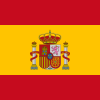





![Army flag under Francoist Spain made for Castles and Forts (1940–1945)[10]](http://upload.wikimedia.org/wikipedia/commons/thumb/d/d2/Flag_of_the_Francoist_Spain_Army_%281940-1945%29_%28Forts_and_Castles%29.svg/141px-Flag_of_the_Francoist_Spain_Army_%281940-1945%29_%28Forts_and_Castles%29.svg.png)


![Royal standard of King Emeritus[11]](http://upload.wikimedia.org/wikipedia/commons/thumb/c/ce/Estandarte_Real_de_Juan_Carlos_I.svg/100px-Estandarte_Real_de_Juan_Carlos_I.svg.png)








